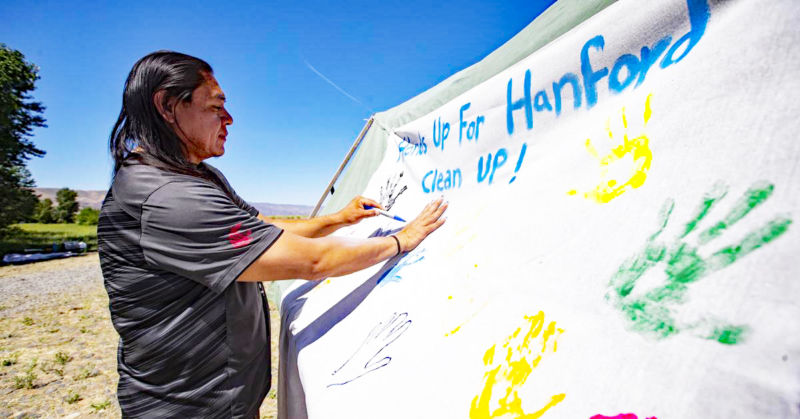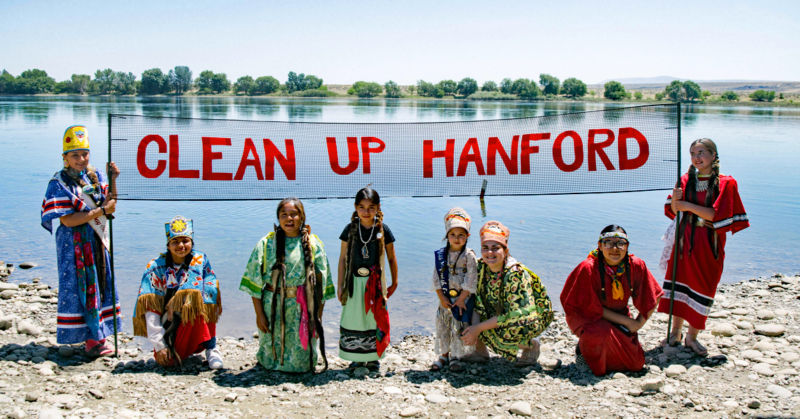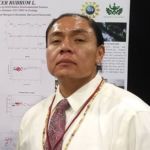Inmi Wawnak-shash iwa ichin Ticham-yaw ku ichin Wana-yaw: “This Land and River is my Body.” A Yakama Nation member explains why cleaning up Hanford is about more than just public safety

Purpose and place: A 2019 Native American ceremony on the Columbia River called for Hands Up for Hanford Cleanup! Photo by Evan Abell/Yakima Herald-Republic
This story is part of Columbia Insight‘s Indigenous Issues series examining environmental stories that directly impact tribal lands and communities.
By Michael A. Buck. October 29, 2020. I am native to Central Washington’s distinguished sage, shrub-steppe and heavy basalt community landscape. The powerful Columbia River within the beautiful “Evergreen” state of Washington is home to the federally recognized Confederated Tribes and Bands of the Yakama Nation, known as River-People or “Wanapum.”
Traditional Yakama members continue to devote heartfelt song and ceremony on behalf of a once thriving, diverse and rich Salmon Culture, ubiquitous in the heart of the Pacific Northwest.
As an undergraduate who studied Environmental Sciences at Heritage University, I am examining a potential contribution to Environmental Health Science, questioning significant Northwest environmental historical truths and uncertainties that may or may not have taken place at traditional Columbia River tribal fisheries.
Present-day indigenous environmental scholars like myself are now reserving a right to methodically listen, document and protect our own history. Traditional Ecological Knowledge (TEK) bridges us to our ancestry, subsequently creating tribal-specific metrics of health within a very limited and contemporary traditional food system of our respective regions.
Treaty of 1855 still governs
The Hanford Nuclear Reservation (Hanford) in Washington is one of the largest sites in the country for the treatment, storage and disposal of radioactive and non-radioactive hazardous waste. It currently stores over 53 million gallons of mixed radioactive and non-radioactive hazardous waste.
During World War II, the United States government constructed Hanford to manufacture plutonium for military purposes. Over the decades, the United States Department of Energy has disposed of approximately 450 billion gallons of contaminated water and liquid mixed waste on the site.
As a result, at least one million gallons of high-level mixed radioactive and non-radioactive hazardous waste have leaked into the environment; 170 miles of groundwater beneath Hanford are contaminated. In addition, tens of millions of gallons of waste remain stored at Hanford in tanks that were constructed in the 1940s and meant to last only 20 years. These tanks are now in danger of failing, with potentially catastrophic consequences.

Hanford Journey: Yakama youth and Elders are elevated by shared experiences on the Columbia River. Photo Kiliii Yuyan
It is very important to uphold the Treaty of 1855 between the United States and Yakama Nation on behalf of the shared region at Hanford. The Treaty of 1855 has implications on Hanford; Yakama land at Hanford was ceded to the United States in the Treaty, with provisions that rights would remain forever. The Treaty involved a grant of land and rights to the United States by Yakama Nation, not the reverse.
The historical, unjust distribution of benefits and burdens between tribal communities and surrounding United States government agencies in our state, in effect, “justifies” the majority of present-day toxic waste and pollution in the Columbia River.
Energy production in Washington has come at the expense of the natural flow of the Columbia and has been a pattern that Indigenous people have witnessed and encountered repeatedly throughout PNW history.
Critical negative social impacts remain self-evident within tribal communities along the Columbia River. These include a dangerous uncertainty of human health effects and questionable water quality at traditional fishing and gathering areas in the region near Hanford.
Restoring a relationship to the land
A dignified environmental history exists and can begin to counter physiological and mental health disparities as a result of identity loss due specifically to relocation and forced acculturation experienced by tribal communities. A colorful history that begins with Columbia River Indigenous tribal Elders and youth ignites self-determination and identity renewal with a vengeance!
Regional environmental histories of the Yakama, Warm Springs, Umatilla, Nez Perce and Wanapum of Priest Rapids are re-emerging as a spirited manifestation of present-day environmental justice practices that command awareness and respect.
According to distinguished environmental justice scholar Joseph R. Desjardins, environmental justice and environmental racism is demonstrated as “an unequal distribution of burdens and benefits amongst people of color … all too often, society places the burdens on people in the least advantaged positions—the poor and people of color for example.”
[perfectpullquote align=”full” bordertop=”false” cite=”” link=”” color=”” class=”” size=””] “It is not the land that is broken, but man’s relationship to the land that is broken.” —Robin Wall Kimmerer[/perfectpullquote]
A human dimension of restoration founded on relationship building exists today in the collaborative and synergistic “Hanford Journey.” This 2019 event hosted by Yakama Nation’s Environmental Restoration Waste Management Program and Columbia Riverkeeper guided transportation by land and water from Vernita Bridge to the Hanford Reach. The event facilitated a reconciliation of societal disconnection with the Reach and Hanford shorelands.
Current Umatilla scholars and anthropologists from this region question the absence of experiencing historically significant places.
“When we do not visit the places our ancestors knew and we do not tend to the rituals of honoring those places in prayer, do we deprive ourselves of the insight and wisdom the land provides? If knowledge of the land is a reflection of knowledge of ourselves, do we become separated from our history when we are separated from our land, the place of our history?” wrote the Cayuse-Umatilla tribal Elder Kakinas (Thomas Morning Owl) in Eugene S. Hunn’s Sahaptian Place Names Atlas “Caw Pawa Laakni (They Are Not Forgotten) in 2015.
The youth and Elders of the Yakama Nation especially will be elevated as mutual beneficiaries of monumental experiences shared on the Columbia. The future health of current youth of the Yakama Nation can count on the experience and dedication of such scholars with whom they can relate.
Revamp outdated policies
We honor and invest time and resources in special delivery of greater awareness to specific goals and objectives that are adjacent to upholding water-quality standards and a higher standard of collaborative integrity that honors multiple generations, human and non-human alike, that rest in the heart of the Columbia.

Michael A. Buck
I invite the dialogue of Columbia River Basin administrators, land-use planners, map-makers, surveyors, monitors, scholars, writers, artists, professors, lawyers, environmentalists, community-based organizers and dedicated scientists to share in a common goal of rebuilding and restoring human relationships with each other and with the river.
As the author and professor Robin Wall Kimmerer once stated: “It is not the land that is broken, but man’s relationship to the land that is broken.”
In a time when the history of “heroes” of this nation is being seriously questioned and even obliterated we can see that the land that my people visited at Hanford always remembered us.
We are a manifestation of this land. We are the Columbia, we are the shrub steppe, we are the deer, we are the huckleberries, we are the roots. That connection will not be broken by an outdated logic of the uninformed.
Michael “Kakinas” Buck is a Yakama Nation member who grew up on the Yakama Nation Reservation. He studies food systems of Indigenous cultures and investigates cases of significant historical environmental injustices.
READ MORE INDIGENOUS ISSUES STORIES.

The Collins Foundation is a supporter of Columbia Insight’s Indigenous Issues series.





